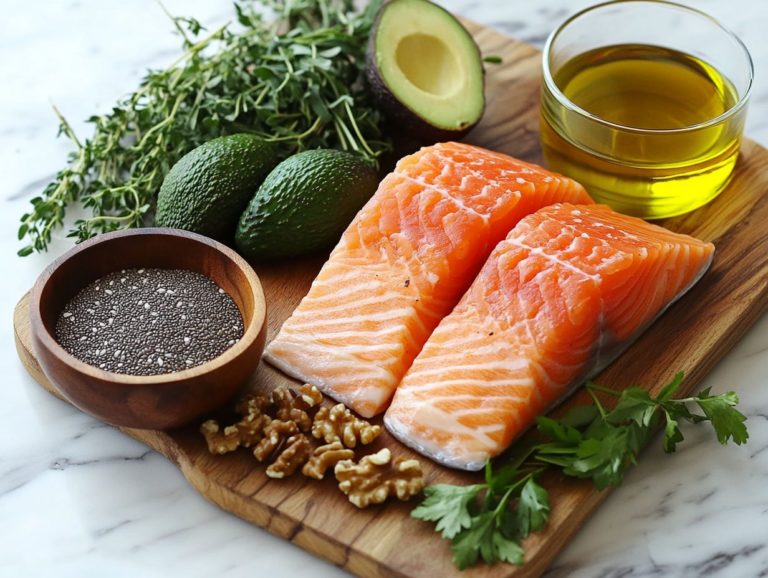How Do I Create a Balanced Plate?
Creating a balanced plate is not just a trendy tip; it s essential for your health and overall well-being.
This guide delves into the importance of balance in your diet. It outlines essential food groups that contribute to a nutritious plate. You ll find practical tips for mastering portion control and embracing variety. The guide also explores the health benefits of mindful eating and addresses common challenges you might face.
Whether you’re looking to refine your eating habits or accommodate specific dietary needs, this guide is designed to assist you in achieving a healthier lifestyle.
Contents
- Key Takeaways:
- The Importance of a Balanced Plate
- The Components of a Balanced Plate
- Tips for Creating a Balanced Plate
- Benefits of a Balanced Plate
- Challenges and Solutions
- Frequently Asked Questions
- What is a balanced plate?
- Why is it important to create a balanced plate?
- How do I determine the portion sizes for a balanced plate?
- Can I still enjoy my favorite foods on a balanced plate?
- How can I create a balanced plate on a budget?
- Are there any specific dietary restrictions I should consider when creating a balanced plate?
Key Takeaways:
- A balanced plate is essential for a healthy diet, providing necessary nutrients and promoting overall well-being.
- A balanced plate consists of various foods from different groups: fruits, vegetables, proteins, grains, and dairy.
- To create a balanced plate, practice portion control, incorporate variety and moderation, and consider alternatives for special dietary needs.
- Start now for a healthier you!
The Importance of a Balanced Plate
The idea of a balanced plate is crucial for anyone seeking to enhance their health and well-being. Eating different foods helps you stay healthy by providing a mix of nutrients your body needs for energy and function.
Focusing on whole foods, the Healthy Eating Plate created by the Harvard T.H. Chan School of Public Health serves as an excellent guideline for meal planning. This approach ensures that each meal is satisfying, nutritious, and reduces the risk of heart disease while promoting a sustainable dietary pattern.
Why Balance is Key to a Healthy Diet
Understanding the significance of balance in your diet is vital for maintaining good health and preventing chronic diseases. Balanced meals with healthy proteins, fiber-rich carbohydrates, and beneficial fats elevate your nutrition and foster overall well-being.
These components work together to regulate your energy levels and support metabolic functions, helping you manage blood sugar effectively.
Practicing mindful eating enhances your awareness of hunger and fullness, guiding you toward better food choices. Over time, this approach can significantly lower your risk of conditions like diabetes and obesity, leading to long-term health and vitality.
The Components of a Balanced Plate
A well-structured balanced plate includes essential components from different food groups: vibrant vegetables, whole grains, lean proteins, and healthy fats, as outlined in Understanding MyPlate: Your Guide to Balanced Meals.
Each element plays a crucial role in delivering necessary nutrients, sustaining your energy, and promoting overall health.
For instance, including fiber-rich carbohydrates from whole grains not only enhances meal satisfaction but also ensures balanced intake of vital vitamins and minerals.
Exploring the Food Groups
To create a balanced plate, it’s essential to explore diverse food groups, focusing on whole grains, a variety of protein sources, vibrant vegetables, and healthy fats.
Whole grains like quinoa, brown rice, and oats should be your go-to staples, as they provide dietary fiber that promotes digestive health and stabilizes blood sugar levels.
For protein sources, consider lean meats, legumes, and dairy products, each offering unique amino acids vital for muscle repair and growth.
Don t forget to add a colorful array of vegetables; they enhance the meal’s appeal and deliver essential vitamins and antioxidants that reduce inflammation and support well-being.
Incorporating healthy oils, such as olive or avocado oil, elevates the flavor of your dishes while supplying heart-healthy fats that aid nutrient absorption and promote cardiovascular health.
Tips for Creating a Balanced Plate
Creating a balanced plate requires careful meal planning and attention to portion sizes to help you meet your nutritional goals.
By following dietary guidelines from experts like the USDA, you can make informed decisions that enhance meal satisfaction and maintain stable blood sugar levels.
Embracing mindful eating practices helps you connect with your body s hunger signals, fostering healthier eating habits that evolve over time.
Portion Control and Proportions
Understanding portion control is crucial for reaching your health goals, as it directly influences the composition of your meals and your nutrition.
Enhance your portion awareness by using visual cues think of a baseball for a serving of fruit or a deck of cards for a serving of protein. These comparisons help you gauge portion sizes with ease.
Using measuring tools like cups and scales allows for precise measurements, especially when you’re just starting.
Following dietary guidelines is essential for creating balanced meals and cultivating a healthier lifestyle.
Making small adjustments to your portion sizes can lead to significant changes in your habits over time. This promotes a sustainable approach to nutrition and overall wellness.
Incorporating Variety and Moderation
Incorporating variety and moderation into your meals is essential for maintaining a balanced diet that fulfills all your nutrient requirements while catering to your food preferences.
By embracing a diverse range of whole foods, you ll savor a delightful spectrum of flavors and textures and enhance your overall meal satisfaction.
When you focus on intuitive eating principles, you ll learn to listen to your body, recognizing subtle hunger cues and satiety signals.
This mindful approach transforms your relationship with food, making it enjoyable and satisfying!
Ultimately, allowing for flexibility in your food choices ensures that your nutritional needs are met over time, supporting both your physical well-being and emotional health.
Benefits of a Balanced Plate
By adopting a Balanced Plate approach, you open the door to a wealth of benefits, including enhanced nutrition and overall health.
This thoughtful strategy can significantly lower your risk of heart disease while boosting your energy levels throughout the day.
Improved Nutrition and Overall Health
Improved nutrition stands out as one of the most significant advantages of embracing a balanced plate. It ensures you receive an adequate intake of dietary fiber, vitamins, and minerals essential for your body’s functions.
These vital nutrients play a crucial role in enhancing your immunity, promoting heart health, and boosting your energy levels.
For example, dietary fiber not only aids in digestion but also helps you maintain a healthy weight.
Vitamins such as A, C, and E support skin health and facilitate cellular repair. Meanwhile, minerals like calcium and magnesium are essential for fortifying bone strength and supporting muscle function.
By cultivating diverse dietary patterns brimming with these essential elements, you can significantly lessen the risk of chronic diseases like diabetes and heart disease, paving the way for improved long-term health outcomes.
Challenges and Solutions
Despite the myriad benefits of maintaining a balanced plate, you will face several challenges that impede your progress.
Factors such as food industry pressures and specific dietary needs often require you to adopt tailored approaches to achieve your nutritional goals.
Overcoming Obstacles to Creating a Balanced Plate
To navigate the challenges of creating a balanced plate, first acknowledge the pressures from the food industry that can skew your perception of healthy eating.
This awareness opens the door to discerning reliable nutritional information amid the cacophony of opinions and fads.
It s essential to turn to reputable sources, like registered dietitians or scientific studies, instead of getting swept away by trendy diets or the latest social media influencers.
Meal planning becomes a vital tool in your arsenal, enabling you to thoughtfully select ingredients and portion sizes that align with your nutritional goals.
Additionally, having a support system can significantly enhance your journey. Whether it s friends, family, or support groups, sharing experiences and challenges fosters accountability and encouragement, making sustainable behavior changes far more attainable.
Alternative Options for Special Dietary Needs
For those with special dietary needs, like allergies or intolerances, finding alternatives can be a challenge. It may feel daunting, but it is essential to embrace healthy eating principles.
Finding options requires creativity and knowledge about food nutrition. By exploring gluten-free grains or dairy substitutes, you can create meals that are safe, satisfying, and nutritious.
Nutrition education is your secret weapon! With this knowledge, you can create meal plans that suit your tastes and health needs.
Frequently Asked Questions
What is a balanced plate?
A balanced plate is a meal that includes various nutrients from different food groups. To achieve this, it’s important to understand how to balance nutrients in a diet, incorporating carbohydrates, protein, healthy fats, and fruits and vegetables.
Why is it important to create a balanced plate?
Creating a balanced plate ensures your body gets the nutrients needed for optimal health. For detailed strategies, check out this guide on how to create a balanced meal plan. It can help you maintain a healthy weight and prevent chronic diseases.
How do I determine the portion sizes for a balanced plate?
Fill half your plate with fruits and vegetables, one-quarter with lean protein, and one-quarter with whole grains. You can also use the MyPlate method, which is a visual guide to help you understand portion sizes.
Can I still enjoy my favorite foods on a balanced plate?
Absolutely! A balanced plate allows for flexibility, so you can enjoy your favorite foods in smaller portions or as occasional treats.
How can I create a balanced plate on a budget?
Buying in-season produce and opting for frozen or canned fruits and vegetables can help you stay within budget. Incorporate affordable protein sources like beans and eggs for balanced meals.
Are there any specific dietary restrictions I should consider when creating a balanced plate?
If you have dietary restrictions or allergies, consult a healthcare professional or registered dietitian. They can help you create a balanced plate that meets your individual needs.






